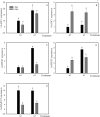Spermidine Enhanced Free Polyamine Levels and Expression of Polyamine Biosynthesis Enzyme Gene in Rice Spikelets under Heat Tolerance before Heading
- PMID: 32488145
- PMCID: PMC7265301
- DOI: 10.1038/s41598-020-64978-2
Spermidine Enhanced Free Polyamine Levels and Expression of Polyamine Biosynthesis Enzyme Gene in Rice Spikelets under Heat Tolerance before Heading
Abstract
High temperatures (HT) before heading strongly inhibit the development of spikelets in rice. Spermidine (Spd) can improve rice's resistance to HT stress; however, the mechanism underlying this effect has not been elucidated. This study investigated several parameters, including yield, superoxide anion (O2.-), protective enzyme activities, and polyamine content, in a heat-sensitive genotype, Shuanggui 1. The yield and yield components decreased dramatically when subjected to HT stress, while this reduction could be partially recovered by exogenous Spd. Spd also slowed the generation rate of O2.- and increased protective enzyme, superoxide dismutase (SOD) and catalase (CAT) activities both under normal and high temperatures, which suggested that Spd may participate in the antioxidant system. Furthermore, genes involved in polyamine synthesis were analyzed. The results show that HT before heading significantly increased the expression of arginine decarboxylase OsADC1, Spd synthase OsSPDS1 and OsSPDS3 and had little effect on the expression of the S-adenosylmethionine decarboxylase OsSAMDC2 and ornithine decarboxylase OsODC1. In addition, exogenous Spd considerably reduced the expression of OsSAMDC2, OsSPDS1 and OsSPDS3 under HT but not the expression of OsADC1. The above mentioned results indicate that the exogenous Spd could help young rice spikelets to resist HT stress by reducing the expression of OsSAMDC2, OsSPDS1 and OsSPDS3, resulting in higher levels of endogenous Spd and Spm, which were also positively correlated with yield. In conclusion, the adverse effect of HT stress on young spikelets seems to be alleviated by increasing the amounts of Spd and Spm, which provides guidance for adaptation to heat stress during rice production.
Conflict of interest statement
The authors declare no competing interests.
Figures



Similar articles
-
Involvement of polyamines in the post-anthesis development of inferior and superior spikelets in rice.Planta. 2008 Jun;228(1):137-49. doi: 10.1007/s00425-008-0725-1. Epub 2008 Mar 14. Planta. 2008. PMID: 18340459
-
Enriched endogenous free Spd and Spm in alfalfa (Medicago sativa L.) under drought stress enhance drought tolerance by inhibiting H2O2 production to increase antioxidant enzyme activity.J Plant Physiol. 2023 Dec;291:154139. doi: 10.1016/j.jplph.2023.154139. Epub 2023 Nov 16. J Plant Physiol. 2023. PMID: 37988872
-
Spermidine alleviates the growth of saline-stressed ginseng seedlings through antioxidative defense system.Gene. 2014 Mar 1;537(1):70-8. doi: 10.1016/j.gene.2013.12.021. Epub 2013 Dec 21. Gene. 2014. PMID: 24365592
-
Targeting polyamine metabolism for finding new drugs against leishmaniasis: a review.Mini Rev Med Chem. 2015;15(3):243-52. doi: 10.2174/138955751503150312141044. Mini Rev Med Chem. 2015. PMID: 25769972 Review.
-
Cancer chemoprevention locks onto a new polyamine metabolic target.Cancer Prev Res (Phila). 2010 Feb;3(2):125-7. doi: 10.1158/1940-6207.CAPR-09-0252. Epub 2010 Jan 26. Cancer Prev Res (Phila). 2010. PMID: 20103728 Free PMC article. Review.
Cited by
-
Functions of Redox Signaling in Pollen Development and Stress Response.Antioxidants (Basel). 2022 Jan 30;11(2):287. doi: 10.3390/antiox11020287. Antioxidants (Basel). 2022. PMID: 35204170 Free PMC article. Review.
-
Unlocking genetic hotspots: GWAS reveals key nitrogen responsive genomic regions and key genes for root and yield traits in indica rice.Mol Genet Genomics. 2025 May 29;300(1):53. doi: 10.1007/s00438-025-02249-3. Mol Genet Genomics. 2025. PMID: 40439778
-
Spermidine-induced improvements in water relations and antioxidant defense enhance drought tolerance in yarrow (Achillea millefolium L.).Heliyon. 2024 Dec 25;11(1):e41482. doi: 10.1016/j.heliyon.2024.e41482. eCollection 2025 Jan 15. Heliyon. 2024. PMID: 39831168 Free PMC article.
-
Emerging strategies to improve heat stress tolerance in crops.aBIOTECH. 2025 Jan 24;6(1):97-115. doi: 10.1007/s42994-024-00195-z. eCollection 2025 Mar. aBIOTECH. 2025. PMID: 40060179 Free PMC article. Review.
-
Mitigation of salinity stress in yarrow (Achillea millefolium L.) plants through spermidine application.PLoS One. 2024 Jun 26;19(6):e0304831. doi: 10.1371/journal.pone.0304831. eCollection 2024. PLoS One. 2024. PMID: 38923971 Free PMC article.
References
-
- Meinshausen M, et al. Greenhouse-gas emission targets for limiting global warming to 2 °C. Nature. 2009;458:1158–62. - PubMed
-
- Liu X, Tang Q, Zhang X, Sun S. Projected changes in extreme high temperature and heat stress in China. J Meteor Res. 2018;32:351–366.
-
- Kotak S, et al. Complexity of the heat stress response in plants. Curr Opin Plant Biol. 2007;10:310–316. - PubMed
-
- Bahar B, Yildirim M. Heat and drought resistance criteria in spring bread wheat: Drought resistance parameters. Sci Res Essays. 2010;5:1742–1745.
-
- Cao YY, et al. Growth characteristics and endosperm structure of superior and inferior spikelets of indica rice under high-temperature stress. Biol Plantarum. 2016;60:1–11.
Publication types
MeSH terms
Substances
LinkOut - more resources
Full Text Sources
Miscellaneous

